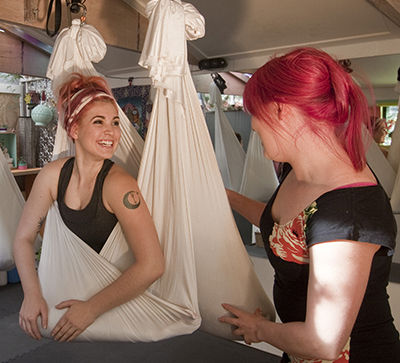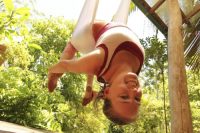
Is this still yoga? Jo Stewart ponders the complexity and rewards of hybrid yoga styles.
by Jo Stewart, Garden of Yoga
A quick google search will turn up all kinds of yoga hybrids—think Bungee Yoga, Antigravity Aerial Yoga, HIIT Yoga, Beer Yoga, Vinyasa + Vino, Doga, Meowga, and Goat Yoga—and these are just a small sample of the pun-tastic world of hybridised yoga.
While I might wonder how yogic some of these combinations actually are, my own classes could be on that list.
I’ve also been to, and thoroughly enjoyed, hula hoop yoga and SUP yoga workshops at festivals. I’ve taught a ‘pilates for yogis’ class and built my own aerial yoga studio.
I often find myself wondering how to best navigate this hybrid realm. I check my ego when I roll my eyes at Beer Yoga or when I internally cringe at being bundled up in YogaDork’s critique of how ‘increasingly gimmicky and bells and tassels and whistles and feathers-laden the yoga world has become – essentially a carnival.’’
Most of all, I wonder how to stay true to the spirit of yoga. Am I enhancing the experience of yoga with the addition of new elements, or diluting it?
I want my students (and myself!) to have the richest, fullest, most productive yoga possible whether they are on the mat or in the hammock – incorporating awareness, breath, philosophy and meditation; respecting this amazing tradition, while being relevant to their lives today.
In a classic yoga teacher move, I look to Yamas and Niyamas to explore these questions…
1) Svadyaya, or self-study.
Are we so busy having a good time that we are overlooking the true power of this practice?
Are we so excited by all these new gadgets—goats, chocolate and hula-hoops—because we are afraid to look into who we really are?Are we just looking for another distraction to avoid facing up to some uncomfortable truths?
Does being on a paddleboard or in an aerial hammock bring us closer to ‘chitta vritti nirodaha’, stilling the fluctuations of the mind, or just make for a great Instagram picture?
It depends.
It depends on our intentions, our teacher and the energy we put into the practice.
Yoga is more than mindful movement and breath; the true power of this practice is its ability to ground us in the present moment – and connect us to who we truly are.
The adaptability and fluidity of this practice have always been one of it’s greatest strengths;Yoga has always evolved depending on who has been teaching and practicing it – However, now there are more paths than ever before, and it’s up to us to decide which ones are worthy of our time and energy.
T.K.V. Desikachar’s speaks to this ability to “adapt past practices to present needs” when he describes the work of his father, Sri T. Krishnamacharya:
The purpose of my father’s erudition was not to preserve the past, but to serve the present and the future. . . My father was a celebrated healer in his own lifetime. This ability, too, owed much to his willingness to adapt past practices to present needs . . . He further proved the value of Yoga in sustaining a lucid, balanced mind in our distracting, stressful, and difficult societies. Toward these ends, he experimented and explored ways to refine Yogic techniques to fit the busy routines of modern life. Even the healing and sustaining powers of Yoga, however, were only a part of his mission. The true purpose of Krishnamacharya’s teaching was to bring Man into contact with something beyond himself, and far greater.
~ Extract from Health, Healing, and Beyond: Yoga and the Living Tradition of T. Krishnamacharya.
2) Asteya, or non-stealing.
The practice of yoga has always been a living, evolving tradition, and one that visionary teachers like Swami Satyananda Saraswati, Swami Vivekananda and Sri T. Krishnamacharya actively worked to share yoga with the world.
Learning about yoga, and respectfully practicing these traditions is not inherently cultural appropriation – the act of a dominant culture, stealing from or exploiting another culture.
However as a white woman practicing an Indian tradition, especially modern variations of it, cultural appropriation, and therefore asteya is something I need to be mindful of.
Picking and choosing elements of sacred traditions for commercial reasons is problematic, especially if elements of that tradition are completely convoluted from their original context.
For some people this is a vinyasa + vino weekend, for some, it is a yoga booty workout, and for others, it’s a ‘Namaste Bitches’ t-shirt. I’ve seen some online articles describing chanting or using Sanskrit in class as respecting tradition, others see it as problematic.
It’s not for me to say which fusion or hybrid styles honour the practice of yoga and which exploit it, but it’s definitely something to stay aware of when navigating my own teaching and practice, especially when I’m bringing in a non-traditional element.
3) Ahimsa, or non-harming.
This is one aspect of yoga that fusion styles can really enhance. I find it much easier to adapt for injury (and injury prevention) when I weave some pilates movements into the practice, especially for older populations.
Pilates tends to focus more on core stability, especially glute strengthening and pelvic stability, and combining some of these movements with the deeper hip stretches, standing or arm balances and back bending asana feels like a nurturing and authentic addition to the practice.
It also means I can offer more alternatives to students working with injuries, or foundational strength and proprioceptive awareness building movements to beginners. Drawing from other movement disciplines gives me some more building blocks to work with.
I’ve also found that the aerial hammock is a fantastic tool to encourage people to be kind to themselves physically and mentally.
The hammock is much more supportive and forgiving than the floor, as it carries some (or all) of our weight. This can have a powerful effect on self-esteem, kinaesthetic awareness and emotional well-being – especially if movement is limited or painful outside of the hammock. It can take the pressure off vulnerable knee and ankle joints, but more importantly this is a place where people can move freely, gracefully and creatively.
I’ve seen students who begin the practice with a negative perception of their bodies grow and blossom. They move from criticising their every move, to just being present and enjoying the practice and themselves.
Of course, this can also happen on the mat, but it seems that the aerial hammock can be a great catalyst for shifting perspective. And the novelty factor of trying something totally new can draw people to the practice (especially when they might have had a bad experience in a more traditional class).
What we learn in the hammock can help us practice with ahimsa on the mat. Inversions like handstand, which usually require a lot of strength and practice without the hammock, are accessible once we have its support.
You have time to hone your alignment, building awareness and strength as you are able to waver from balance and re-stabilise without falling. This new found awareness and strength translates back into the traditional variations of each asana. The fabric means it is possible to get the benefits of an inversion without weight bearing on the head or neck.
As a full-time yoga and Pilates teacher, I have noticed that teaching a variety of different movement styles is much kinder to my body than teaching exclusively vinyasa. Mentally as well, the change of perspective of teaching a mixture of styles helps me remain present for each student. I also have more energy to go other teachers’ classes and to put into my own practice.
I have noticed that my approach to yoga has changed since I started teaching fusion styles.
When I’m calling my class ‘aerial yoga’, it feels particularly important to emphasise the non-physical aspects of the practice and to consciously teach yoga, not just movement.
Mixing yoga with other styles of movement raises the question – ‘Is this still yoga?’
Asking myself this question has strengthened my resolve to honour the richness of this amazing tradition so that I can answer with an unreserved ‘yes’.
Our yoga is not a retreading of old walks, but a spiritual adventure.
– Sri Aurobindo (1872-1950), extract from letter to disciple (date unknown)
About Jo

Jo Stewart discovered yoga while studying Visual Art at RMIT in 1998, and since then she has found that practicing meditation and yoga helps her enjoy living and creating to her full potential.
Jo has been teaching for over 10 years and runs her own Melbourne studio, Garden of Yoga, where she teaches Antigravity Aerial Yoga, Pilates, Yin and Vinyasa classes to small groups. She is a level 3 Senior teacher with Yoga Australia.
Jo’s creative approach adapts to each practitioners individual needs. This includes performing artists looking to balance the rigours of their training with a more nurturing approach – which (along with her own love of hooping) has lead her to formulate the “Self Care for Hula Hoopers” series of workshops and youtube videos.
Jo loves teaching yoga and mandala making at festivals, including Kawaii Purapura international Yoga Festival (NZ), Yogafest, and Rainbow Serpent Festival.
Follow her on Instagram and Youtube.



Indeed, it is the approach and attitude that makes it yoga <3. Love your post!